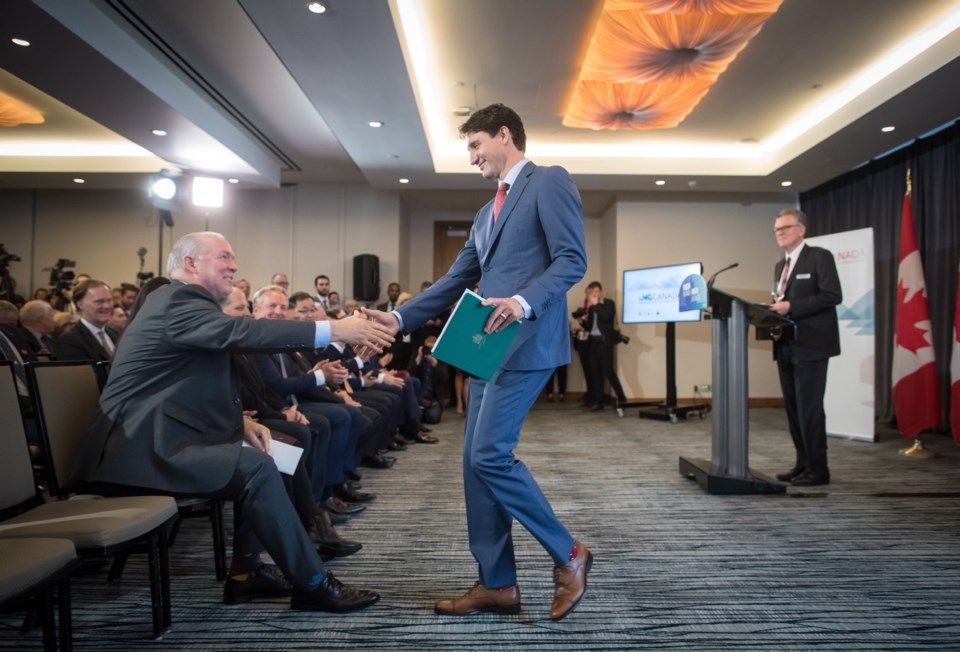Premier John Horgan “has made things very difficult for himself,” Green Party Leader Andrew Weaver said Tuesday, in the midst of LNG Canada’s Champagne moment. You wouldn’t know it, listening to the premier.
Horgan couldn’t stop smiling as he hugged Prime Minister Justin Trudeau and enthused over the $40-billion bet investors just made on B.C.’s ability to produce and move natural gas on a grand scale.
He said it was humbling to be a part of news that will make life better for people around the world. Particularly in B.C., where the Kitimat-based project will pump $23 billion into the treasury over 40 years.
But Weaver and some environmental groups skipped the party. The government is irresponsible to welcome “staggering carbon pollution,” said the David Suzuki Foundation.
Other outfits were more guarded, but stressed the challenge of accommodating more emissions into a plan aimed at driving B.C.’s overall output dramatically down.
Weaver’s reaction was the most intriguing, given that Horgan owes his job to him.
He mass-messaged supporters hours after the consortium made the final investment decision, encouraging them to “write Premier Horgan about his reckless decision to pursue the LNG industry after years of criticizing Christy Clark for doing the same thing.”
Weaver said he was “deeply disappointed by the NDP tax giveaway.
“Rest assured, we did everything we could to deter them from making this awful decision.”
The three-member Green caucus is obviously ready to hold to the principle that burning any kind of fossil fuel anywhere is wrong.
But when it comes to “making things very difficult for himself,” Weaver’s stand fits the bill perfectly. If he takes that position into an election, he’s going to get a hard lesson in how important hope and prosperity are to people.
Greens could fall honourably on the principle that cutting emissions should come first, above all else.
But they’re likely to fall hard. Taking a hard-line stance against any thought of using natural gas means rejecting the big swell of hope that is coursing through northern B.C.
The B.C. Liberals won two elections in a row partly just on the airy hope that an LNG industry might develop. Being in power when that hope became a reality this week gives the NDP an undeniable boost.
Rejecting any thought of the compromises that come with LNG leaves the Greens fighting an impression that’s dogged them for years — that of being an environmental fringe group that is against everything except windmills and electric cars.
The contrast between their view and most other outlooks on Tuesday was striking. The NDP and the Liberals were so excited about the future they even managed to congratulate one another. First Nations leaders could scarcely believe their dreams are on the verge of coming true. Business and labour were over the moon about a bright new future.
Then there’s Weaver’s take.
“If they are going to insist on going down this dark road, deeper into the fossil fuel industries of yesteryear, they will need to work with the B.C. Liberals,” he wrote supporters.
The NDP will do just that over the short term. Officials said there will be no votes on LNG matters this fall that would force a showdown.
Over the longer haul, if the Greens vote against LNG, it could do a lot more damage to them than to the LNG industry. Bills will pass easily, 83-3, and the trio will face questions about how much they expect B.C. to give up to pursue their goal.
B.C.’s emissions are a small campfire compared to the coal-fired infernos spewing in other parts of the world. They should be curtailed. But not at the expense of the biggest private project in Canada’s history, one that goes toward cutting dirtier fuels elsewhere.
“I will have more to say on this topic when the clean growth plan becomes public later this year,” Weaver said in the email.
In the background is the upcoming referendum vote. If voters opt for change, the electoral system can’t be adapted before July 2021.
Greens are counting on proportional representation to boost their seat count. So raging against LNG has to be balanced against their need to see this parliament through to 2021.
About the project: $40-billion LNG project will export B.C.’s natural gas
• Plans include a liquefied natural gas plant for Kitimat and a 670-kilometre pipeline delivering natural gas from the northeast corner of the province
• The plant will chill the natural gas, liquefying it; the LNG will be loaded onto ships for shipment to overseas customers.
• The $40-billion joint venture involves five partners: Royal Dutch Shell, Mitsubishi Corp., Petronas, PetroChina Co. and Korea Gas Corp.
• The federal government has pledged $275 million in support.
• LNG Canada has said it is ready to proceed with construction. The first liquefied natural gas is expected to be shipped before the middle of the next decade.
• The province estimates the LNG plant and pipeline will create up to 10,000 construction jobs and generate about $23 billion in revenue for the government over 40 years. Up to 950 people will operate the plant.



